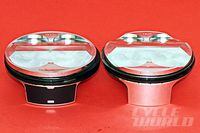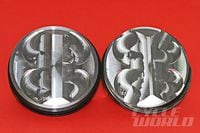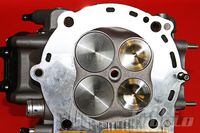Formula 1 and MotoGP engines have extreme bore/stroke ratios that slow combustion by creating combustion chambers that are vertically too thin to leave room for turbulence that lasts through top dead center. To renew that turbulence, squish areas are created outside the “valve footprint.” As these flat outer regions of the piston rush at corresponding flat areas on the head, the fuel/air mixture between then is “squished out,” forming fast moving inward jets that stir what’s in the chamber. Even with squish, ignition has to occur painfully early (as in more than 60 degrees BTDC) in such thin, wide chambers, and this creates heat loss and forces much of the charge to burn at less than peak compression.
How close to the head can the piston safely come? In the TZ250 Yamahas of the 1970s, we would begin to see "bright areas" on piston and head at .018 in. (just under half a millimeter). This indicated that piston-to-head contact was beginning. This was with steel connecting rods, a 54mm stroke, and max rpm between 11,500 and 12,000 rpm. Because these were roller engines, that .018 in. was not all from rod stretch at TDC; some was surely bearing internal clearance and rolling element deflection.
In the era of 750 Superbikes, I saw vertical squish clearance without contact around .025 in. (0.64mm), again with steel connecting rods, 46 to 48mm strokes, and 14,000 rpm.
Now, I see F1 sites asserting that titanium connecting rods in the now-departed era of 19,000-rpm V-10s were stretching 0.6 to 0.8mm during deceleration to top dead center on the exhaust stroke. That means the static piston-to-squish clearance had to be quite large. So large that at lower rpm, where the rod stretches less, squish would have a lot less stirring effect, possibly resulting in detonation.
This could be why another rumor circulates: that some teams have switched traditional titanium connecting rods to equally strong but only half as stretchy rods made of maraging steel. If true, this would allow static squish clearance to be reduced by half, meaning that squish would work that much better at lower rpm than with titanium rods.



/cloudfront-us-east-1.images.arcpublishing.com/octane/52RV7YUTCRCY7KWFR5HXYD46LY.jpg)
/cloudfront-us-east-1.images.arcpublishing.com/octane/IIWHAT6TXBBFZNCCXLUUVFHTQI.jpg)
/cloudfront-us-east-1.images.arcpublishing.com/octane/R43KEDHNA5AXZOXPFWW6FIAWIA.jpg)
/cloudfront-us-east-1.images.arcpublishing.com/octane/FEZBVXVT5ZCLPBKQU65N233J3Y.jpg)
/cloudfront-us-east-1.images.arcpublishing.com/octane/UR5PVVVXLJCCRMJL2CI5XTBTKA.jpg)
/cloudfront-us-east-1.images.arcpublishing.com/octane/CZQBAFVOJJH6BJF7QRLZUTORIM.jpg)
/cloudfront-us-east-1.images.arcpublishing.com/octane/VFYUM4X4KRGDHEGYLM22BKQICA.jpg)
/cloudfront-us-east-1.images.arcpublishing.com/octane/6ZST3K4CRZAPJHEHGFUPW5QTZ4.jpg)
/cloudfront-us-east-1.images.arcpublishing.com/octane/FX7P3VV7OBD25NQZENLC7Z2C2Y.jpg)
/cloudfront-us-east-1.images.arcpublishing.com/octane/RGWDY7OB65BUNEEC5QIKVWDS6E.jpg)
/cloudfront-us-east-1.images.arcpublishing.com/octane/YIQBPU45RJCRHGFHFCWVBZVXKQ.jpg)
/cloudfront-us-east-1.images.arcpublishing.com/octane/JQYYZOU2VBDNPO2QQS672REQHE.jpg)
/cloudfront-us-east-1.images.arcpublishing.com/octane/XKJT4SI6HZAOTO4SBDVU66L2MQ.jpg)

/cloudfront-us-east-1.images.arcpublishing.com/octane/4UVTXD2DPVDEXCSLBMDAPEFWNQ.jpg)
/cloudfront-us-east-1.images.arcpublishing.com/octane/NREVLYTAKNB3NIIQRJGCGYBXHU.jpg)
/cloudfront-us-east-1.images.arcpublishing.com/octane/GVKW4WSC4NA6XEL3JPDGSTRRSA.jpg)
/cloudfront-us-east-1.images.arcpublishing.com/octane/ZCHPADKJI5EZPCFRD6HUMI6RAA.jpg)
/cloudfront-us-east-1.images.arcpublishing.com/octane/OTYNIYDLG5BMRIVZW2TFBAW5R4.jpg)
/cloudfront-us-east-1.images.arcpublishing.com/octane/NENHT3MW2JFV5M3JPHXOHVTLXQ.jpg)
/cloudfront-us-east-1.images.arcpublishing.com/octane/KO7HERZNSRG2FOIAQCLCNXYQYA.jpg)
/cloudfront-us-east-1.images.arcpublishing.com/octane/GASJTXMDUBCGDDJAUVS22I7BEA.jpg)
/cloudfront-us-east-1.images.arcpublishing.com/octane/BDU4JR5GBVE4JOG6TMYAKKM5WQ.jpg)
/cloudfront-us-east-1.images.arcpublishing.com/octane/HLIXJRNJ7FFXJDBH5QLH2BF3PI.jpg)